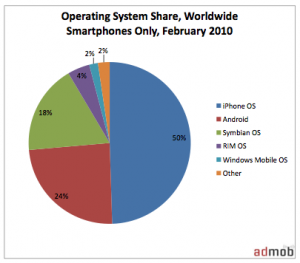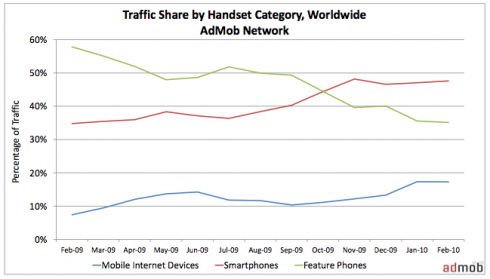Admob has just released its February 2010 Mobile Metrics Report and the data is showing some interesting trend in the worldwide mobile traffic scene. Â Key point is the fact that Admob’s worldwide traffic for smartphones contributes 48% to the total mobile traffic in February 2010. This is a big increase from last year’s 35%. And guess where those traffic are coming from? – heavy application usage on iPhone and Android phones.
Meanwhile the other two mobile categories, feature phone and mobile Internet devices also get some increase in traffic. Â Although overall traffic from feature phones decreased to 35% from 58% in the same period last year, its absolute traffic still increased by 31%. For mobile Internet devices, worldwide traffic grew to 17%. Most of the traffic from this kind of devices came from the iPod Touch, Sony PSP and Nintendo DSi. Â Would these change once the iPad is shipped? That remains to be seen. But as well know the iPad belong to this category.
 For the traffic per smartphone category, as expected the iPhone still gets the biggest chunk of mobile traffic as monitored by AdMob. Share of smartphone requests for the iPhone increased from 33% to 50%.  For Symbian platform, the share of request decreased from 43% to 18%. And guess which platform is getting Symbian’ share of request?  Obviously it’s the Google Android mobile platform. In fact Android is now the fastest growing mobile OS on a year-over-year metrics.
For the traffic per smartphone category, as expected the iPhone still gets the biggest chunk of mobile traffic as monitored by AdMob. Share of smartphone requests for the iPhone increased from 33% to 50%.  For Symbian platform, the share of request decreased from 43% to 18%. And guess which platform is getting Symbian’ share of request?  Obviously it’s the Google Android mobile platform. In fact Android is now the fastest growing mobile OS on a year-over-year metrics.
The top five Android devices as noted by AdMobe are the Motorola Droid, HTC Dream, HTC Hero, HTC Magic, and the Motorola CLIQ.
Originally posted on March 25, 2010 @ 9:56 am
